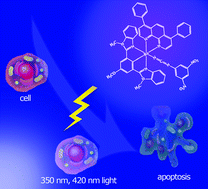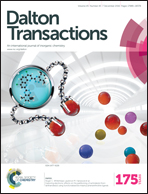New RuII pincer complexes: synthesis, characterization and biological evaluation for photodynamic therapy†
Abstract
Three new ruthenium(II) complexes of NCN pincer and phenylcyanamide derivative ligands of the formula [Ru(L)(Ph2phen)(3,5-(NO2)2pcyd)], 1, [Ru(L)(Me2phen)(3,5-(NO2)2pcyd)], 2, and [Ru(L)(Cl2phen)(3,5-(NO2)2pcyd)], 3 (HL: 5-methoxy-1,3-bis(1-methyl-1H-benzo[d]imidazol-2-yl)benzene, 3,5-(NO2)2pcyd: 3,5-(NO2)2pcyd, Ph2phen: 4,7-diphenyl-1,10-phenanthroline, Me2phen: 4,7-dimethyl-1,10-phenanthroline, Cl2phen: 4,7-dichloro-1,10-phenanthroline) have been synthesized and studied as potential photosensitizers (PSs) in photodynamic therapy (PDT). The complexes exhibited promising 1O2 production quantum yields comparable with PSs available on the market. The DNA-binding interactions of the complexes with calf thymus DNA have been studied by absorption, emission, and viscosity measurements. All complexes cleave SC-DNA efficiently on photoactivation at 350 nm with the formation of singlet oxygen (1O2) and hydroxyl radicals (˙OH) in type-II and photoredox pathways. Complexes 1–3 showed very good uptake in cervical cancer cells (HeLa). The compounds studied were found to exhibit low toxicity against HeLa cells (IC50 > 300 μM) and, remarkably, on non-cancerous MRC-5 cells (IC50 > 100 μM) in the dark. However, 1 showed very promising behavior with an increment of about 90 times, in its cytotoxicity upon light illumination at 420 nm in addition to very good human plasma stability.


 Please wait while we load your content...
Please wait while we load your content...